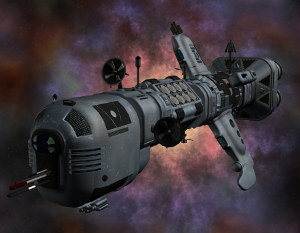by Tom Stephens
Introduced shortly after the formation of the United Planetary Federation, the Talnor Class Communications Ship plays a critical role in the day to day operations of Spacefleet. Although the class has seen several updates over its service lifetime, the current version, Model D, still serves the primary role of the original ships, namely fleet communications and reconnaissance.
Ship Roles
The Talnor communications ship is not a front line ship but rather a fleet support vessel. At least one of these ships is attached to each of Spacefleet's Task and Strike Forces to provide communications support for both in-system and Frontier wide messages. The Talnor class ship is equipped with multiple videocom and subspace receivers and transmitters.
In addition to its plentiful communications gear, the Talnor class ships sport powerful sensors and computers to track, analyze, and monitor everything going on in space around it. It is not uncommon for a Task Force's chief tactical officer to actually be on the Task Force's comm ship to have access to the data and resources on-board to better plan and coordinate operations.
Besides traveling with Spacefleet's Task Forces and operations groups, a number of Talnor Class vessels are deployed around the Frontier as mobile communication nexuses to facilitate the general operation of Spacefleet. Capable of monitoring multiple subspace transmissions from every system in the Frontier and Rim simultaneously, and not having to worry about being on the wrong side of the planet, the Talnor class vessels provide a mobile backup to Spacefleet communications around the Frontier.
A final role played by the Talnor Class vessels is that of forward reconnaissance. These vessels are often deployed into areas where Spacefleet wants information. With their powerful sensors and communications monitoring gear, they can collect data and relay it back to Spacefleet command.
As there are a fairly large number of Talnor class vessels in service, and life on board is fairly sedate compared to a front-line Spacefleet warship, these ships tend to see a large number of trainee crew members. The relatively calm operations on these vessels, at least the ones serving the communication nexus role, lends itself to opportunities for on-ship training without the extra stress that comes with working on a front-line vessel. It is not uncommon for over a quarter of the crew on a Talnor vessel that is working the communication nexus role to be trainees on their first extended voyage. It is also not uncommon for any graduate of Gollwin Academy to have served at least one training tour on a Talnor class vessel at some time in their career.
|
Author's Note: This ship doesn't quite follow the standard KH ship design rules. However, the deviations are fairly small, namely the inclusion of a deluxe white noise broadcaster on a small ship and a few more lifeboats than the rules allow for. If you want a strictly canon ship, simply remove four of the lifeboats and downgrade the WNB to a standard model (and reduce the cost by 720,000 cr). Otherwise, everything else is per the standard KH rules for starship construction. |
Ship Design
At its core, the Talnor class ship is a giant broadcasting and receiving station. In its current incarnation, the Talnor-D sports 50 subspace radios and two dozen videocom radio transmitter/receivers. It also has a powerful radar and energy sensors system. The computers onboard are larger than typically found on spacecraft and optimized to collect, analyze, decrypt, and translate signals received on all of the ship's communication channels.
The rest of the ship is built around supporting this communication function. The ship itself is built from a size 6 hull, just like StarFleet's destroyers. In fact, from a distance, the Talnor can easily be mistaken for a McCoy class destroyer. Up close, however, the differences are readily apparent as the Talnor class vessels are bristling with communications gear.
Like the destroyers it resembles, the Talnor vessels sport three Class B atomic engines and are fully capable of maneuvering like their sister ships. However, they are not as heavily armed – sporting only two laser batteries for local defense. And while they don't carry masking screens, they have quadruple the number of ICMs (20) for missile defense. The extra weapon space is instead taken up by the communications gear and sensors.
Finally, in addition to the communication and sensor gear, the Talnor class sports a deluxe white noise broadcaster system. Typically this system is only found in the largest vessels but has been specially built into the Talnor class design. When necessary, this WNB allows a Talnor class ship to deny communications capability to enemy vessels, even when supporting a smaller task group that doesn't include one of the UFP battleships.
The Talnor class vessels also have a lot of built-in redundancy. There is a complete backup for the life support, radar, and energy sensor systems. In addition, there is a complete secondary computer system that is an exact mirror of the functionality of the primary system. Thus the vessel can sustain damage from combat and/or random malfunctions and still operate at maximum efficiency.
Optional Combat Rule
If desired, the Referee can allow this redundancy to have an effect in the Knight Hawks board game. At the referee's discretion, the Talnor vessel can ignore the first "Combat Control System" and "Damage Control" hits on the Advanced Game Damage Table. This represents the redundant computer systems onboard these vessels kicking in and taking over those functions.
Additionally, since the communications gear is such a large component of the ship's function, the referee can treat any "Weapon Hit" that would normally damage a Rocket Battery, Electron Battery, or Proton Battery as damaging 1d10 subspace radios. These can continue to be damaged until all 50 are destroyed.
Ship's Crew
Talnor class vessels typically deploy with two complete blue/gold crews that can keep the ship operating at full efficiency around the clock. In addition to the Captain and Executive Officer, who typically lead the blue and gold crews respectively, each of the gold and blue crews typically contains the following members:
- 2 pilots
- 2 astrogators
- 3 starship engineers
- 3 technicians
- 2 robotics technicians
- 2 energy gunners
- 1 defensive systems specialist
- 2 radar/energy sensor specialists
- 4 local (i.e. videocom) communications specialists
- 15 subspace communications technicians
- 2 linguists
- 3 computer specialists
- 3 security personnel
- 3 cook/chefs
- 1 corpsman/medic
Most routine maintenance and janitorial services on board the ship are handled by robots under the direction of the robotics technicians and various other crew members.
Knight Hawks Statistics
HS: 6 HP: 40 DCR: 70
Engines: 3 Class B Atomic (6 pellets loaded)
ADF: 3 MR: 3
Weapons: LB LB
Defenses: RH ICM (x20) Decoy(x1)
Crew Size: 98
Maximum Crew Capacity: 120
Life Support Capacity: Primary – 200, Secondary – 200
Communications Equipment: 50 Subspace Radios, 24 Videocom Radios, 50 extra videocom screens, 4 master intercom panels, 200 intercom speaker/mike panels
Computer (level 5, 342 FP): Drive 5, Astrogation 4, Laser Battery 1, Laser Battery 1, ICM 3, Cameras 1, Skin Sensors 1, Cargo Arm 2, Life Support 1, Life Support 1, Damage Control 3, Computer Lockout 5, Alarm 3, Communications 4, Analysis 6, Information Storage 6, Language 6, Computer Security 4, Installation Security 4
Vehicles: 6 escape pods, 5 lifeboats, 2 small launches, 2 large launches, 3 workpods
Other Equipment: Deluxe Astrogation suite, 2 x radar systems, 2 x energy sensor systems, Cameras, Skin Sensors, Deluxe White Noise Broadcaster, Cargo Arm, complete backup computer system.
Cargo/Storage Capacity: 1,500 m3
Cost: 5,921,200 cr.


